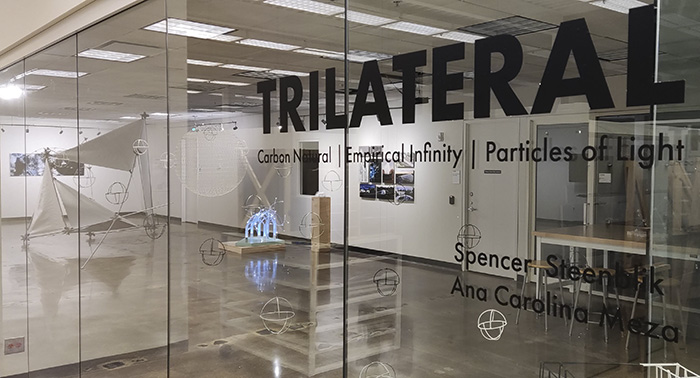
Date/Time
Date(s) - February 17, 2023 - March 4, 2023
12:00 am
Location
The Republic Building
Categories No Categories
Exhibition: Trilateral – Carbon Natural | Empirical Infinity | Particles of Light
Friday February 17th – March 04, 2023
A closing reception for the exhibition will be held Thursday, March 2 from 6:30 to 8 p.m.
https://eskenazi.indiana.edu/events/speaker-series/march-series/2023-02-17-steenblik-meza.html
TRILATERAL: Carbon Natural | Empirical Infinity | Particles of Light is an exhibition of works by the J. Irwin Miller M. Arch program’s Ana Meza and R. Spencer Steenblik. The exhibition showcases a collaborative project and one project from each participant. The name has deep reference to each project. Simple connections include the molecularly inspired axial symmetry fundamental to the Carbon Natural project; the exhibition title also refers to Empirical Infinity’s subject matter for a homonym; and Particles of Light uses three pavilions to harken back to the title.
Empirical infinity is an installation of delicate objects made from PLA, generally used for 3D printing. This work investigates structural systems, transparency, fragility, spatial relations, and optical effects. The connecting point system is very versatile because it creates translucent sculptures that appear to have volume, thus making any 3D shape. The artwork conveys motifs of immigration, such as the in-between, disassociation, and the normalcy of the cultural “insider” and “outsider.” The use of transparency, fragility, and wireframe appearance attempts to capture the universality of migration in all its manifestations.
Particles of Light Pavilions is a collaboration between Meza and Steenblik, along with support from Ignition Arts. The proposal for a University anniversary gift including three schemes with a single focus on the theme of light and edification. All three schemes focus on the use of fiber optics and a shape inspired by the shape of light particles. The first scheme consists of trilaterally arranged particles of light pavilions placed on polished dark granite to accentuate their influence. The second Scheme introduces a third bridge from primary gathering place on campus to the Administration building with a grand pavilion as a part of the bridge structure, it being the brightest of the three pavilions in this scheme highlights the progression of an individual as they gain more knowledge and understanding. The third scheme focuses on multiple smaller sculptural instantiations shedding light throughout the campus, possibly one at the south end of campus amongst the trees, another near the student center, and so on being a constant reminder that one’s influence and trajectory with the new knowledge asked through higher education.
The Carbon Natural Project uses a double trilateral configuration inspired by the carbon molecule. The project follows the lineage of Konrad Wachsmann, Frei Otto, and tensegrity. We seek to find the optimal place between the less than accessible mass-customization glorified today and the very regular mass-produced standardized spaceframes predominant in today’s construction industry. This research; working with world class chemists to explore the potentials of the carbon molecular structure scaled to the construction scale; has explored materials and processes and are happy to share our successes and failures along this journey thus far. Working at many scales, on a molecularly inspired structural system for almost four years, we have moved from scale models to full scale experimental installations around the world and are pushing the possibilities made available through this innovation.
The range of joints displayed demonstrate the iterations employed in our testing process. The large sculptural digital painting entitled ‘Asymmetrical Blizzard’ shows the system operating through multiple scaled joint and strut configurations. The skin material is an insulative material with a high R value to thickness and weight ratio, preparing the system for a scale increase, allowing the system to go from artistic installation into a performative system.
Other installations of the project include:
Magnolia, Zeya, Zhejiang, China 2022; Lonsdaleite, 2021, Hainan, China; The Bohr Model, Wenzhou China, 2020-21; Carbon Alignment, Great Basin Desert, USA, 2020; Artemis Sciencefair, Oakland, CA, 2019; The original Carbon Natural 01, 02, 03 2019, Wenzhou, China
Biographies:
Ana C. Meza is a sculpture artist from Colombia based in Columbus, IN. In 2008 she immigrated from Colombia to the United States. She graduated with a Bachelor of Interior Architecture and sculpture degree from Indiana University. She developed a series of sculptures inspired by design, patterns, and structures like buildings, bridges, stairs, and ladders. More at anameza.info.
R. Spencer Steenblik has built, taught, published, exhibited, and curated globally. His work negotiates vernacular and advanced digital processes through interdisciplinary, sustainable and natural inspiration, to create urban intricacy and interactive spaces. His practice, phi architecture, focuses on designing across scales. He holds a masters in architecture from SCI-Arc. More at phi.archi.

